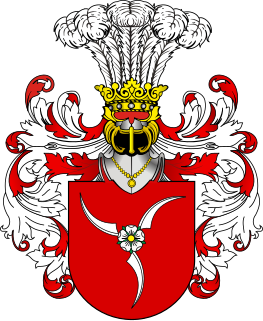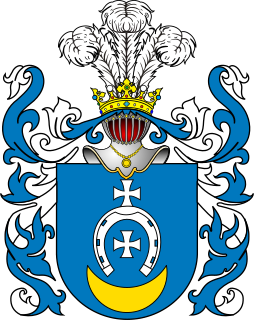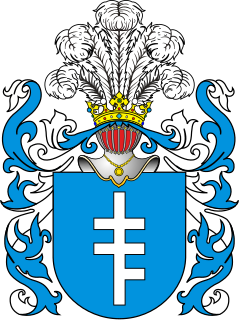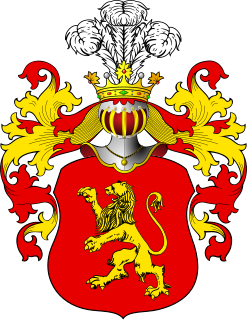
The Kostka (Kostkowie) was a Polish noble family (szlachta) originated from Kashubia.

The Kostka (Kostkowie) was a Polish noble family (szlachta) originated from Kashubia.
The Kostka family used the "Dąbrowa" arms.

Nałęcz is a Polish coat of arms. It was used by associated szlachta families in the Kingdom of Poland and the Polish–Lithuanian Commonwealth (1569–1795).

Ciołek is a Polish coat of arms, one of the oldest in medieval Poland. It was used by many szlachta (noble) families under the late Piast dynasty, under the Polish–Lithuanian Commonwealth, during the Partitions of Poland, and in the 20th century. The variant names "Siolek" and "Cialek" arose from miscommunication among early-20th-century Polish immigrants to the United States.

Rola is a Polish coat of arms. It was used by several szlachta families in the times of the Kingdom of Poland and Polish–Lithuanian Commonwealth.

Zadora - is a Polish coat of arms used by the szlachta.

Topór is a Polish coat of arms. It was used by several szlachta (noble) families in medieval Poland and under the Polish–Lithuanian Commonwealth.

Srzeniawa is a Polish coat of arms. It was used by several szlachta families in the times of the Kingdom of Poland and the Polish–Lithuanian Commonwealth.

Herburt is a Polish coat of arms. It was used by several distinct and unrelated szlachta families such as the Pawcz family of Ruthenian Galicia. A coat of arms is an individual or family heirloom the origins of which lie in the 12th century.

Wieniawa is a Polish coat of arms. It was used by several szlachta families in the times of medieval Poland and the Polish–Lithuanian Commonwealth.

Bożawola - is a Polish coat of arms. It was used by several szlachta families.

Hozyusz is a Polish coat of arms. It was used by several szlachta families.

Drużyna is a Polish coat of arms. It was used by several szlachta families in the times of the Kingdom of Poland and the Polish–Lithuanian Commonwealth.

Piława is a Polish coat of arms. It was used by many noble families known as szlachta in Polish in medieval Poland and later under the Polish–Lithuanian Commonwealth, branches of the original medieval Piława Clan (Pilawici) family as well as families connected with the Clan by adoption.

Lubicz is a Polish nobility coat of arms.

Prince Aleksander Ostrogski was a nobleman of the Polish–Lithuanian Commonwealth.

Dąbrowa is a Polish coat of arms originated from the Duchy of Masovia.

Zofia Odrowąż (1537–1580) was a Polish noblewoman. She was the daughter of castellan and voivode Stanisław Odrowąż and only daughter of Anna of Masovia, last Masovian duchess of the Piast dynasty, and became the widow of the castellan of Wojnicz and castellan of Sandomierz. She married firstly, Hetman Jan Krzysztof Tarnowski and secondly, castellan and voivode Jan Kostka in 1569.

Achinger is a Polish coat of arms. It was used by several szlachta families in the times of the Kingdom of Poland and the Polish–Lithuanian Commonwealth.

Lew II - Polish coat of arms, used by several genera. Two of them were families from the region of Kaszuby. Coat of arms "Lew II" is a variant of the coat of arms "Leo".

The Sieniawski family was a Polish szlachta family. They were magnates in the First Republic of Poland. Their properties were inherited by the Czartoryski family after the family expired in the 18th century.

Brodzic is a Polish coat of arms. It was used by several szlachta families in the times of the Polish–Lithuanian Commonwealth.